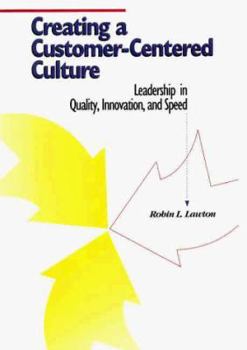Creating a Customer-Centered Culture: Leadership in Quality, Innovation, and Speed
Many organizations have found it difficult to transfer the Voice of the Customer methods and technologies developed for manufacturing quality and apply them to knowledge and service work. This how-to... This description may be from another edition of this product.
Format:Hardcover
Language:English
ISBN:0873891511
ISBN13:9780873891516
Release Date:January 1993
Publisher:ASQ Quality Press
Length:177 Pages
Weight:1.30 lbs.
Dimensions:0.9" x 7.3" x 10.3"
Customer Reviews
5 ratings
Critical Gap Has Been Bridged!
Published by Thriftbooks.com User , 23 years ago
Robin Lawton has shared with us a missing link! There are books that discuss how to fix problems, books about the "balanced scorecard", and books about meeting customer expectations. However, none of them seemed able to address a critical question: what objective measure will enable us to track our level of success? By answering that question, this book enahnces the value of all other volumes on six sigma, management, and problem solving. Lawton does so by guidng the reader through a straightforward process. By all means, read the other books - but only after you read this one first!
A "Must Read" and "Must Act Upon"
Published by Thriftbooks.com User , 24 years ago
With the vast array of performance improvement and customer focus books on the market, readers need to be somewhat selective about what they read. This book should definitely be on any manager's list. The tools described in the book apply to any type of organization, public or private, and at any level of the organization. At the Missouri Department of Revenue, we've used Robin Lawton's customer-centered culture approach as a touchstone for many successful Performance Excellence Teams.The only thing worse for a results-oriented leader than not reading this book would be to read it and not put it into action. Unlike so many performance improvement books, the clear guidance is more than matched by the clarity and simplicity of the steps to implementation.
Rethinking work, quality, and satisfaction.
Published by Thriftbooks.com User , 24 years ago
This is a great thought provoking book. It proposes a paradigm shift in the way we think about work, about how we organize ourselves, and how we can create fans out of customers. It is also a hands on manual with a practical guide to how we can make changes in our organizations and dramatically improve the way we do things. In doing our work, most of us concentrate on the issues that pre-occupy us and the organizations we work for - issues like "How much does it cost us to produce such and such?"; "How well are we organized?"; "Do our processes comply with policy/standards/established procedures, etc.?" This little book suggests that we think about our work as a matter of producing discreet products. For those who are in service and information organizations, this is not an easy concept to grasp initially. It requires a paradigm shift in thinking. However, once you see the work you do in these terms, you can then (1)identify the "customers" of such products and (2)begin applying product redesign concepts to create customer satisfaction. For anyone who is ready for a leadership challenge in their organization, this book is required reading.
What do your customers want? Rob tells you how to find out!
Published by Thriftbooks.com User , 24 years ago
Not all customers are created equal. Some are indeed the end user, others broker or "fix" your product or service on behalf of the end user. Where does your company focus it's energies? And does your company really focus on what the end customer wants? And are you really measuring what the end customer truly cares about (versus what you, the producer cares about)? Read this illuminating book that gives you the secrets to Creating a Customer-Centered Culture within your organization. I have found Rob Lawton's model extremely useful for manufacturing as well as service organizations. I highly recommend it!
A roadmap to improve customer service satisfaction!
Published by Thriftbooks.com User , 24 years ago
Robin Lawton has managed to articulate a model for improving customer satisfaction that makes sense. As a university president, I have too often been disappointed by many other approaches that focus on quick-fix training rather than using a broad framework for really measuring and improving internal and external customer satisfaction. Lawton's process begins by getting the reader to understand that even service industry employees have products that can be measured and improved. His method shows how to get employees and customers together to define end-user requirements. He also makes the reader aware that most customer service surveys are not worth much because end-users are typically not part of the survey design process. The whole customer satisfaction approach outlined by Lawton is clear, focused and a must read for all executives concerned about really improving customer satisfaction holistically.




